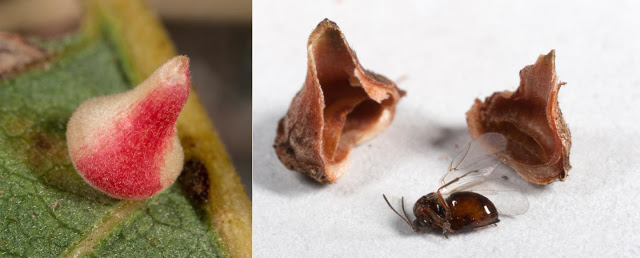
The La Brea Tar Pits, the world’s richest Ice Age fossil site, is famous for saber-toothed cats, mammoths, and giant sloths, but it also has numerous insect and plant fossils. New research on fossil galls–abnormal plant growths caused, in this case, by tiny wasps–helps reconstruct the local habitats of Southern California at the end of the last Ice Age. The work, led by Anna R. Holden of the Richard Gilder Graduate School at the American Museum of Natural History and the La Brea Tar Pits and Museum, was recently published in the journal Quaternary Research.
“Most people associate the Ice Age with freezing temperatures and an entirely different landscape from the present,” Holden said. “But this study shows that the environment and climate around Southern California has not drastically changed since that time.”
Galls are abnormal growths on plant leaves, twigs, or branches that form in response to stimulation from invading insects, mites, bacteria, fungi, and viruses. Cynipid wasps, which lay their eggs inside plant tissue, are one of the most common gall insects. The larvae use galls for both protection and food before they emerge. Because these cynipid wasp species still live today, as is the case with most insects excavated from the tar pits, Holden, with paleobotanist Diane M. Erwin, and gall researchers Kathy Schick and Joyce Gross–all from the University of California, Berkeley–identified and linked records of the fossil gall plant hosts (mostly oaks) and their current habitat associations to the late Ice Age at the La Brea Tar Pits. This suggests that many habitats, such as coniferous forest, mixed evergreen, woodlands-savannah, and chaparral–tangled shrubs and thorny bushes–were present in Southern California between 33,000 and 44,000 years ago–the approximate date of most of the fossil galls.
“Assuming that ecological conditions required by native plants in California during the Late Pleistocene were the same as those prevailing today, the diversity of the fossil galls indicates that almost every kind of habitat existing in California at present also existed during the Late Pleistocene,” Holden said. “This suggests that a radical change or turnover in climate did not occur. Our snapshot of the prehistoric conditions of southern California is becoming clearer as we compile information from insect and plant studies.”
In order to identify certain specimens, the researchers used micro-computed tomography (CT) to compare the locations of larval chambers in modern specimens to those in the fossils.
The 13 fossil specimens the researchers studied are housed at the La Brea Tar Pits and Museum, and were recovered from different tar pits, including the Museum’s ongoing excavation “Project 23.” Dating back to the beginning of the 20th century, scientists have unearthed more than 5 million fossils representing over 600 species of plants and animals from the Tar Pits–evidence that Los Angeles was densely populated by wildlife for more than 50,000 years.
“The Tar Pits offer a unique perspective for understanding the environmental evolution of southern California,” said Luis Chiappe, vice president of research and collections at the Natural History Museum of Los Angeles County. “Saber-toothed cats speak of a bygone world while countless microfossils shed light on our changing world. In a sense, the Tar Pits are like the Roman god Janus; one face looks into the past and the other looks into the future.”
Reference:
Anna R. Holdena, Diane M. Erwind, Katherine N. Schicke, Joyce Gross. Late Pleistocene galls from the La Brea Tar Pits and their implications for cynipine wasp and native plant distribution in southern California. DOI:10.1016/j.yqres.2015.09.008
Note: The above post is reprinted from materials provided by American Museum of Natural History.










